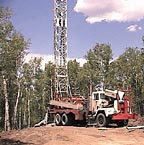
First, consider the actual size rig you will need. Make an honest appraisal of the depth and size of the holes you typically drill, and match the rig to the job. I know a driller who bought a rig about two sizes too big for his work. He wanted it for the occasional big job, and to cut down on maintenance, he wanted it heavy enough so he wasn’t ever in a bind. Guess what? In addition to a bigger rig, he got bigger payments, a lot of locations he can’t fit in and, while his competitor is going to the next job, he’s either winching out or filling ruts! Bottom line: less bottom line.
Next, see if you can figure out why the seller is selling. Not all rigs are sold because they are junked out and no longer able to work. If you ask a few questions and dig a little, there’s probably a different story for every rig. Since drillers seldom retire, sometimes a driller just up and dies, and his widow is faced with the job of selling the rig. Sometimes you can get a good deal on a good rig, but I would caution you not to try to buy the rig for a scrap price if she doesn’t know its value. It may be the only retirement money she has.

Another factor that affects rig prices and availability is the normal, boom-and-bust cycles of the industry. Over the years, the shot-hole drillers and the coal bed methane drillers have been notorious for buying up everything that will turn to the right, running them ’til the market dries up and dumping them. These can be good deals, but be careful: Sometimes the drillers get paid by the foot, and common maintenance goes by the wayside. You might get a good price, except the rig needs a new everything!
When you’ve finally settled on the rig type you need and have a couple prospects to look at, here are some tips: It seems like it ought to be a corollary to Murphy’s Law, that the more attractive a rig seems, the farther away it is. Every time I call about a rig and want to go look, it seems like it’s at least 1,000 miles away, more likely 2,000!
When you do finally get there and see the rig, first impressions naturally are going to be a big part of your decision process. A word to the wise: Don’t be fooled by the paint. Sometimes sellers do a Sherwin-Williams rebuild and hide serious problems. A freshly painted rig is a red flag to me. First, it probably isn’t my company color, and second, I want to see all the wear points and repaired areas. These rigs usually sell to ‘investors’ or young drillers with stars in their eyes. A rig that is drilling is the best one to look at. If it’s not, ask the owner to rig it up and drill a test hole. A hundred feet of test hole will tell me more than 14 pages of checklists and receipts.

Don’t worry too much about the expendable parts either. Pump swabs and rods, tong dies and the like are going to have to be replaced anyhow, and if you do it, you know it was done right and when it was done. Spend more time looking at the expensive items. The gear end of a pump is an expensive pain-in-the-butt to change, and its condition should affect the price significantly. Take a close look at the rotary. The rotary drive shaft, u-joints and pinion bearings take the most abuse on a rig. Since they usually are up under the rig, they often are one of those out-of-sight, out-of-mind parts that will give you a good idea of the overall condition of the rig and how much routine maintenance it has had.
Another potential problem on some older rigs is the transfer case. At the time some of these rigs were built, trucks commonly had gasoline engines and much less horsepower and torque. When you remount the rig on a newer truck with a high-torque diesel engine, it might be too much for the transfer case to handle. I know of one rig that has had the transfer case through-shaft replaced five times, until the owners finally installed a larger transfer case.
Look closely at any extensive repairs or modifications the owner has made. Are they properly done and safe? Be careful of derrick and crown modifications — that stuff is over your head! If the seller is not the driller who has been running the rig, ask to talk to the driller: He can tell you what the rig needs, how it runs and a wealth of other information.
If you do make a deal and buy the rig, and it’s a long way from home, consider having the rig hauled rather than driving it. Rigs often are mounted on low-geared, off-highway trucks that really don’t like a lot of freeway cruising. A commercial hauler will have the equipment, permits, insurance, fuel cards and everything it takes to get the rig safely to your yard. It’ll be quicker and cheaper than having to sit at the dreaded DOT checkpoint, replacing tires and taillights five states from home!
Finally, consider getting a professional appraisal of the rig. It’s not too expensive — we charge about $300 plus expenses — and may reveal a hidden problem that would significantly change the value of the rig. It also may save you considerable time to send someone else to do it while you stay home and make money instead of traveling around, looking at rigs. Then you can just go look at the best one(s) and make your decision.
If I can help you with this or any other problem, e-mail me at rockbit@compuserve.com or call me at (912) 265-1839.



Report Abusive Comment